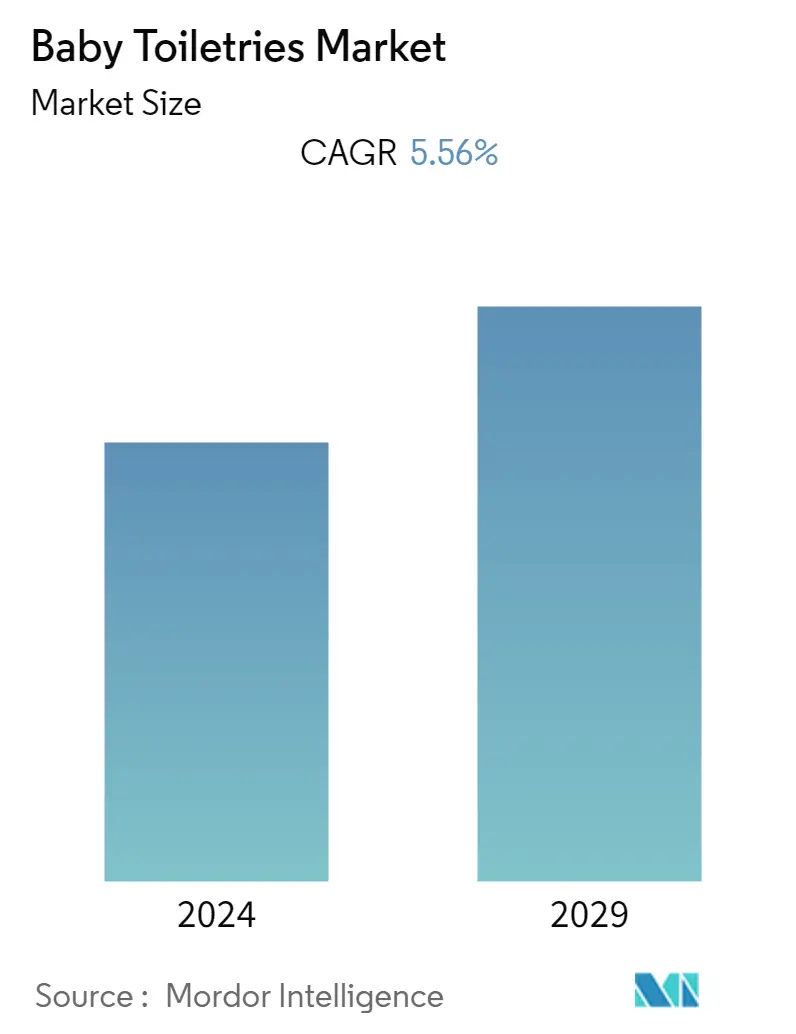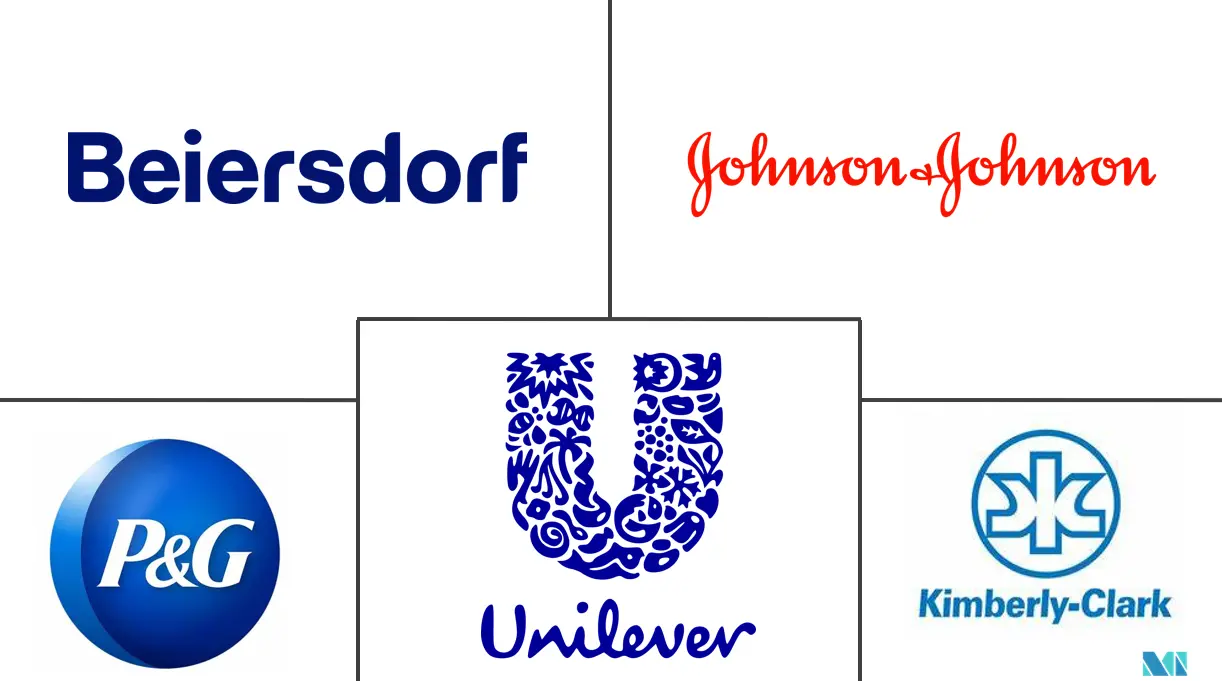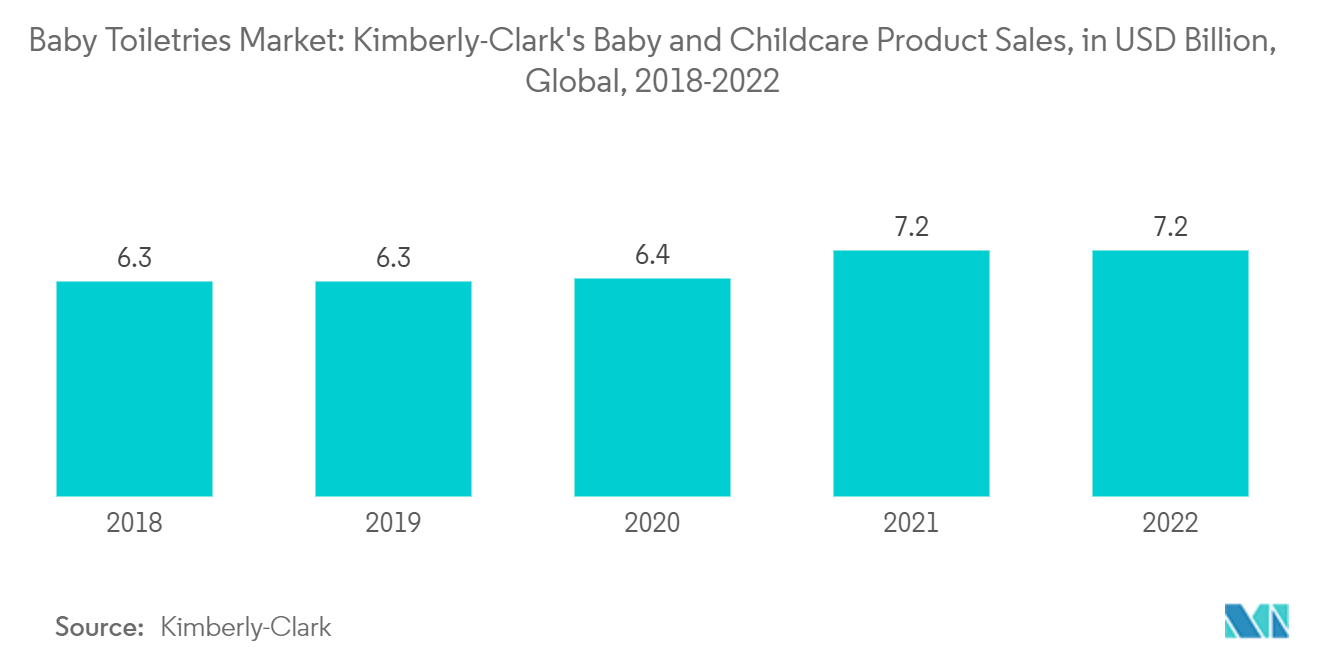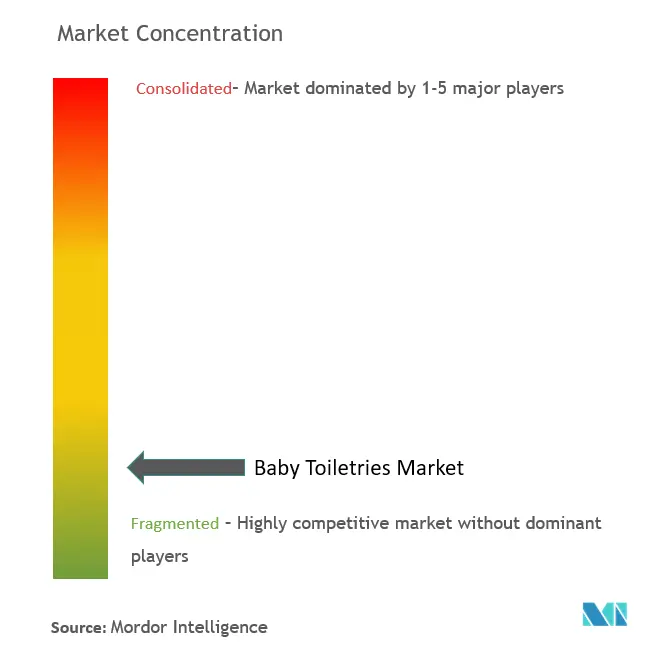Baby Toiletries Market Size

| Study Period | 2019 - 2029 |
| Base Year For Estimation | 2023 |
| CAGR | 5.56 % |
| Fastest Growing Market | Asia Pacific |
| Largest Market | North America |
| Market Concentration | Low |
Major Players
*Disclaimer: Major Players sorted in no particular order |
Baby Toiletries Market Analysis
The baby toiletries market size is expected to grow from USD 70.19 million in 2023 to USD 92 million by 2028, at a CAGR of 5.56% during the forecast period (2023-2028).
- The demand for baby toiletries is increasing across the world owing to the increasing demand for protective baby care products. Parents are choosing products that are clean, labeled, and natural. Owing to this, the market players are launching natural baby care products in the market.
- In July 2022, BabyChakra launched its very first range of baby care products, including moisturizing baby body wash, baby hair oil, natural diaper rash cream, baby massage oil, and others that are made with 100% natural and certified organic ingredients. The rising demand for more transparency in the ingredients of baby toiletries from consumers has been changing the market dynamics for the last few years.
- Furthermore, the birth rate is increasing in many regions like the Asia Pacific. According to the National Bureau of Statistics of China data from 2022, the birth rate in China was 6.77 thousand in 2022. Physical distribution channels, such as hypermarkets and baby stores, are the significant revenue-generating channels of various baby carrier products, but the share of the e-commerce channels in the baby care products market is also expected to witness significant growth.
- Additionally, the e-commerce market is also growing owing to rising disposable income. New online websites like Cetaphil, The Mom and Co., Softsens, and others are launching new products in the market. In June 2023, Plum, a vegan Indian beauty brand, launched baby care products that include baby lotion, body wash, baby shampoo, and massage oil.
Baby Toiletries Market Trends
Increasing Demand for Organic Baby Care Products
- The demand for organic baby care products is increasing among parents as their awareness about harmful synthetic chemicals in baby care products is increasing. Organic baby care products like skincare products, diapers, and other products are increasing among consumers. Due to rising disposable income, high-quality and environmentally friendly baby care products are preferred by parents.
- The market players are innovating new types of diapers with the use of organic and soft fabric and organic ingredients. Because of environmental conditions like UV radiation, desert areas, dry environments, and many more, babies in those regions get affected easily as babies' skin is sensitive.
- Furthermore, due to rising disposable income, consumers are opting for the use of premium baby care products. Market players are launching new organic products in the market to cater to consumer demand. For instance, in February 2021, WaterWipes launched the world's purest baby wipes that contain organic fruit extract and 99.9% of water.

Asia Pacific is the Fastest Growing Market
- Robust economic growth and rising household incomes are expected to increase consumer spending on baby care products, including toiletries, in the region. Asia-Pacific is one of the fastest-growing markets for baby care products due to the rising birth rate. Increasing brand penetration and a vast distribution network are also driving the baby care products market in the region.
- Environmental issues like ultra violet (UV) rays, dry air, and heat are increasing, due to which consumers are opting for the use of protective skincare products for their babies. Therefore, the demand for baby oils, lotions, moisturizers, and other products is increasing. Additionally, the e-commerce sector in the baby toiletries market is also growing.
- New online websites like FirstCry.com, mama earth, Hopscotch.com, and many more are providing desirable products to consumers at low prices with offers and discounts, which is also driving the market. In April 2023, Kinu Baby Care introduced an organic baby care range with the launch of baby lotion, body wash, baby oil, and baby shampoo.

Baby Toiletries Industry Overview
The baby toiletries market is fragmented, with regional and global players dominating the market. Key players in the market include Kimberly-Clark Corporation, Beiersdorf AG, Procter & Gamble Company, Johnson & Johnson Services Inc, and Unilever Plc.
The market players in the market are advertising their products through different channels to increase their product reach. Key brands are embarking on mergers and acquisitions since their primary focus is to increase revenue and optimize offerings.
Baby Toiletries Market Leaders
-
Kimberly-Clark Corporation
-
Beiersdorf AG
-
Procter & Gamble Company
-
Johnson & Johnson Services Inc
-
Unilever Plc
*Disclaimer: Major Players sorted in no particular order

Baby Toiletries Market News
- March 2023: Kimberly-Clark relaunched Huggies Complete Comfort baby diapers in India. The company claims that the relaunch of the product focused on 5-in-1 comfort for babies that include softness and absorption.
- October 2022: R for Rabbit launched a new baby care line, Pure & Beyond. The product range includes baby care products like baby creams, lotions, soaps, body washes, shampoos, baby powders, and baby oils. The company claims that the products are made with plant-based ingredients.
- April 2022: Sanosan, a premium baby skincare brand, launched a baby cleansing range that includes baby bath & shampoo, baby soap, and wash foam. The company claims that the products are enriched with hydrolyzed milk protein and organic olive extract.
Baby Toiletries Market Report - Table of Contents
1. INTRODUCTION
- 1.1 Study Assumptions and Market Definition
- 1.2 Scope of the Study
2. RESEARCH METHODOLOGY
3. EXECUTIVE SUMMARY
4. MARKET DYNAMICS
-
4.1 Market Drivers
- 4.1.1 Increasing Demand for Organic Baby Care Products
- 4.1.2 Increasing Product Innovation in the Market
-
4.2 Market Restraints
- 4.2.1 Possibility of Rashes and Allergic Reactions
-
4.3 Porter's Five Forces Analysis
- 4.3.1 Threat of New Entrants
- 4.3.2 Bargaining Power of Buyers/Consumers
- 4.3.3 Bargaining Power of Suppliers
- 4.3.4 Threat of Substitute Products
- 4.3.5 Intensity of Competitive Rivalry
5. MARKET SEGMENTATION
-
5.1 Type
- 5.1.1 Skin Care Products
- 5.1.2 Hair Care Products
- 5.1.3 Baby Diapers
- 5.1.4 Baby Wipes
- 5.1.5 Other Product Types
-
5.2 Distribution Channel
- 5.2.1 Supermarkets/Hypermarkets
- 5.2.2 Specialist Retailers
- 5.2.3 Convenience Stores
- 5.2.4 Online Retail Stores
- 5.2.5 Other Distribution Channels
-
5.3 Geography
- 5.3.1 North America
- 5.3.1.1 United States
- 5.3.1.2 Canada
- 5.3.1.3 Mexico
- 5.3.1.4 Rest of North America
- 5.3.2 Europe
- 5.3.2.1 Spain
- 5.3.2.2 United Kingdom
- 5.3.2.3 Germany
- 5.3.2.4 France
- 5.3.2.5 Italy
- 5.3.2.6 Russia
- 5.3.2.7 Rest of Europe
- 5.3.3 Asia Pacific
- 5.3.3.1 China
- 5.3.3.2 Japan
- 5.3.3.3 India
- 5.3.3.4 Australia
- 5.3.3.5 Rest of Asia-Pacific
- 5.3.4 South America
- 5.3.4.1 Brazil
- 5.3.4.2 Argentina
- 5.3.4.3 Rest of South America
- 5.3.5 Middle East and Africa
- 5.3.5.1 South Africa
- 5.3.5.2 United Arab Emirates
- 5.3.5.3 Rest of Middle East and Africa
6. COMPETITIVE LANDSCAPE
- 6.1 Most Adopted Strategies
- 6.2 Market Share Analysis
-
6.3 Company Profiles
- 6.3.1 Johnson and Johnson Services
- 6.3.2 Beiersdorf AG
- 6.3.3 The Himalaya Drug Company
- 6.3.4 Cotton Babies Inc
- 6.3.5 Procter & Gamble Co.
- 6.3.6 Kimberly Clark Corp.
- 6.3.7 KAO Corporation
- 6.3.8 Unilever Plc
- 6.3.9 Honasa Consumer Pvt Ltd (mamaearth)
- 6.3.10 Himalaya Global Holdings Ltd
- *List Not Exhaustive
7. MARKET OPPORTUNITIES AND FUTURE TRENDS
** Subject To AvailablityBaby Toiletries Industry Segmentation
Baby toiletries are products that are essential for bathing the baby, skincare, and other care products.
The baby toiletries products market is segmented by product type into diapers, skincare products, hair care products, bathing products, wipes, and other product types. By distribution channels, the market is segmented into supermarkets/hypermarkets, specialist retailers, convenience stores, online retail stores, and other distribution channels. The market is segmented by Geography into North America, Europe, Asia Pacific, South America, and the Middle East and Africa.
For each segment, the market sizing and forecasts have been done on the basis of value (USD).
| Type | Skin Care Products | |
| Hair Care Products | ||
| Baby Diapers | ||
| Baby Wipes | ||
| Other Product Types | ||
| Distribution Channel | Supermarkets/Hypermarkets | |
| Specialist Retailers | ||
| Convenience Stores | ||
| Online Retail Stores | ||
| Other Distribution Channels | ||
| Geography | North America | United States |
| Canada | ||
| Mexico | ||
| Rest of North America | ||
| Geography | Europe | Spain |
| United Kingdom | ||
| Germany | ||
| France | ||
| Italy | ||
| Russia | ||
| Rest of Europe | ||
| Geography | Asia Pacific | China |
| Japan | ||
| India | ||
| Australia | ||
| Rest of Asia-Pacific | ||
| Geography | South America | Brazil |
| Argentina | ||
| Rest of South America | ||
| Geography | Middle East and Africa | South Africa |
| United Arab Emirates | ||
| Rest of Middle East and Africa |
Baby Toiletries Market Research FAQs
What is the current Baby Toiletries Market size?
The Baby Toiletries Market is projected to register a CAGR of 5.56% during the forecast period (2024-2029)
Who are the key players in Baby Toiletries Market?
Kimberly-Clark Corporation, Beiersdorf AG, Procter & Gamble Company, Johnson & Johnson Services Inc and Unilever Plc are the major companies operating in the Baby Toiletries Market.
Which is the fastest growing region in Baby Toiletries Market?
Asia Pacific is estimated to grow at the highest CAGR over the forecast period (2024-2029).
Which region has the biggest share in Baby Toiletries Market?
In 2024, the North America accounts for the largest market share in Baby Toiletries Market.
What years does this Baby Toiletries Market cover?
The report covers the Baby Toiletries Market historical market size for years: 2019, 2020, 2021, 2022 and 2023. The report also forecasts the Baby Toiletries Market size for years: 2024, 2025, 2026, 2027, 2028 and 2029.
Baby Toiletries Products Industry Report
Statistics for the 2024 Baby Toiletries Products market share, size and revenue growth rate, created by Mordor Intelligence™ Industry Reports. Baby Toiletries Products analysis includes a market forecast outlook to 2029 and historical overview. Get a sample of this industry analysis as a free report PDF download.



